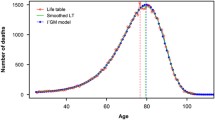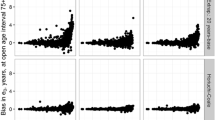Abstract
Two novel methods of life expectancy estimation, applied to various annual reported demographic datasets, are proposed. First, for datasets that fully recorded birth date and death date of all dead individuals, we rely on the well-known Kaplan–Meier estimation method to provide an accurate estimation framework of life expectancy. Our proposed method can be used as a gold standard in the accuracy investigation of other life expectancy estimation methods. The method can be applied for small areas, where complete mortality data are regularly produced by routine annual surveys. The second new created method, called as local parametric method, based on the theoretical background of survival process with local parametric Weibull distributions, estimates life expectancy using abridged survival data. Experiments on real longitudinal datasets show the new method provides very exact life expectancy estimations for 10 among 15 one-year datasets, whilst the method of Chiang often yields overestimations.

Similar content being viewed by others
References
Bebbington M, Lai CD, Zitikis R (2006) Useful periods for lifetime distributions with bathtub shaped hazard rate functions. IEEE Trans Reliab 55(2):245–251
Chiang CL (1972) On constructing current life tables. J Am Stat Assoc 67(339):538–541
Chiang CL (1978) Life table and mortality analysis. World Health Organization, Geneva
Chiang CL (1984) The life table and its applications. Robert E Krieger Publ Co, Malabar
Cristia JP (2009) Rising mortality and life expectancy differentials by lifetime earnings in the United States. Working paper no. 665, Inter-American Development Bank, Research Department, Washington, DC
Eyler JM (1979) Victorian social medicine. The ideas and methods of William Farr. Johns Hopkins University Press, Baltimore
Eayres D, Williams ES (2004) Evaluation of methodologies for small area life expectancy estimation. J Epidemiol Commun Health 58:243–249
Fifth annual report of the registrar general, 1843. HMSO, London
Golbeck AL (1986) Probabilistic approaches to current life table estimation. Am Stat 40(3):185–190
Greville TNE (1943) Short methods of constructing abridged life tables. Rec Am Inst Actuar 32(Part 1):29–42
Griffiths C, Fitzpatrick J (2001) Geographic inequalities in life expectancy in the United Kingdom, 1995–1997. Health Stat Q 09:16–28
Hsieh JJ (1991) A general theory of life table construction and a precise abridged life table method. Biom J 33(2):143–162
Juckett DA, Rosenberg B (1993) Comparison of the Gompertz and Weibull functions as descriptors for human mortality distributions and their intersections. Mech Aging Dev 69(1–2):1–31
Kaplan EL, Meier P (1958) Non-parametric estimation from incomplete observations. J Am Stat Assoc 53:57–81
Kaplan RM, Spittel ML, Zeno TL (2014) Educational attainment and life expectancy. Policy Insights Behav Brain Sci 1(1):189–194
Keyfitz N (1966) A life table that agrees with the data. J Am Stat Assoc 61:305–311
Keyfitz N (1970) Finding probabilities from observed rates or how to make a life table. Am Stat 24(1):28–33
King G (1914) On a short method of constructing an abridged mortality table. J Inst Actuar 48:294
Koletsi D, Pandis N (2017) Survival analysis, part 2: Kaplan-Meier method and the log-rank test. Am J Orthod Dentofac Orthop 152(4):569–571
Lee ET, Wang JW (2003) Statistical methods for survival data analysis. Wiley, Hoboken
Manton KG, Stallard E, Tolley HD (1991) Limits to human life expectancy: evidence, prospects, and implications. Popul Dev Rev 12(4):603–637
Meulen A (2012) Life tables and survival analysis. Statistics Netherlands, The Hague/Heerlen
Nguyen TKC, Vinod KD (2003) FilaBavi, a demographic surveillance site, an epidemiological field laboratory in Vietnam. Scand J. Public Health 31(Suppl. 62):3–7
OECD (2017) Life expectancy, in pensions at a glance 2017: OECD and G20 indicators. OECD Publishing, Paris
Pinder JE III, Wiener JG, Smith MH (1978) The Weibull distribution: a new method of summarizing survivorship data. Ecology 59(1):175–179
Pollard JH (1989) On the derivation of a full life table from mortality data recorded in five-year age groups. Math Popul Stud 2(1):1–14
Reed IL, Merrell M (1932) On a short method of constructing an abridged life table. Am J Hyg 30:33–62
Silcocks PBS (2004) Improving estimation of the variance of expectation of life for small populations. J Epidemiol Commun Health 58:611–612
Silcocks PBS, Jenner DA, Reza R (2001) Life expectancy as a summary of mortality in a population: statistical considerations and suitability for use by health authorities. J Epidemiol Commun Health 55:38–43
Toson B, Baker A (2003) Life expectancy at birth: methodological options for small populations. National Statistics Methodological Series No. 33. A National Statistics publication, Her Majestyas Stationery Office, Norwich
Weibull W (1951) A statistical distribution function of wide applicability. J Appl Mech 18(3):293–297
Wilmoth JR, Andreev K, Jdanov D, Glei DA (2007) Methods protocol for the human mortality database. University of California, Berkeley, and Max Planck Institute for Demographic Research, Rostock. http://www.mortality.org/Public/Docs/MethodsProtocol.pdf. Accessed 26 Jan 2021
Wilson DL (1994) The analysis of survival (mortality) data: fitting Gompertz, Weibull, and logistic functions. Mech Ageing Dev 74:15–33
Acknowledgements
The analysis in Sect. 4 of this study has been realized by using the longitudinal dataset of FilaBavi—Ba Vi Epidemiological Field Laboratory. Thanks are due to Prof. Dr. Nguyen Thi Kim Chuc, the main coordinator of FilaBavi, and to other scientists and workers who participated in conducting many years surveys and processing to produce the dataset, that plays a critical role for this study.
Author information
Authors and Affiliations
Corresponding author
Additional information
Communicated by Luiz Duczmal.
Rights and permissions
About this article
Cite this article
Ho Dang, P., Nguyen, T.N. New methods of life expectancy estimation. Environ Ecol Stat 29, 587–606 (2022). https://doi.org/10.1007/s10651-022-00536-5
Received:
Revised:
Accepted:
Published:
Issue Date:
DOI: https://doi.org/10.1007/s10651-022-00536-5




